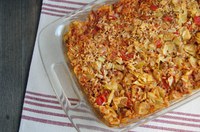Prairie Fare: Prom Dress Dilemma Brings Coronavirus Impact Home
(Click an image below to view a high-resolution image that can be downloaded)
By Julie Garden-Robinson, Food and Nutrition Specialist
NDSU Extension
“I can’t believe this,” I said to myself.
I was checking the status of my online order. My package has been “stuck” in California since Feb. 11, according to the tracking information. Now it’s early March.
I finally reached out to the seller.
“Due to the coronavirus, your order is still in China,” she wrote. “We will have them rush the order.”
I was not confident in this rushing process. We had been waiting eight weeks.
I marched into the next room to tell my husband the bad news.
“Our daughter’s prom dress is still in China,” I stated. “Prom is in three weeks.”
He sighed heavily. Prom dresses are a big deal to many teenage girls. A really big deal.
We had spent an afternoon with her trying on dresses. I would not spend $700 on a dress. I found a similar dress online for a fraction of the price.
It was emerald green, which she wanted. The company had great reviews. The shop selling it was on the East Coast, and we ordered it 2 1/2 months before the big day.
I went upstairs to deliver the bad news to our daughter next.
“What are we going to do?” our 16-year-old exclaimed. “All my friends have dresses!”
“We will figure out something for you to wear,” I said.
I am sure I have ruined her teenage life by not buying the expensive dress. Someday this will be a story for her to tell.
Most likely, another shop would have ordered the dress from China. We would be in the same (slow) boat, so to speak.
Finding a dress may involve me sharpening my sewing skills and doing some alterations. This was a small bump in the road in a health crisis that is circling the globe.
Even though the virus has not sickened anyone in North Dakota to date, the far-reaching dimensions of our global market had hit home.
We all have been inundated with messages about the virus. Almost every newscast begins with “breaking news” about COVID-19, a specific strain of the corona family of viruses that has caused many illnesses and deaths.
Have you been listening to the recommendations?
Try these questions about strategies recommended by the Centers for Disease Control and Prevention (CDC). These steps can reduce our risk of becoming ill from a variety of viruses, including colds and the flu:
- How long should we wash our hands (in seconds)?
- You stop to wash your hands before eating lunch in a restaurant. What are the first two steps in the handwashing process?
- If handwashing facilities are not close at hand, a hand sanitizer is an option. What percent alcohol should your hand sanitizer be?
- You wake up feeling sick with a fever and chills and you need to be at work in less than an hour. What should you do?
- Does the CDC recommend facemasks for general use by people in the community?
- If you are coughing or sneezing, how can you help protect yourself and others?
- About how far (in feet) should you maintain a distance between yourself and others who might be sick?
- Hand-to-hand contact can spread germs. What are some alternatives to handshakes?
Here are the answers.
- Wash your hands with soapy water for a minimum of 20 seconds. That’s the amount of time to sing “Happy Birthday” twice. The next time you wash your hands, I challenge you to watch the second hand on a watch as you scrub and sing.
- The first steps in the handwashing process are turning on the water and wetting your hands. Many people put soap on before wetting their hands. After scrubbing and rinsing, wipe your hands with a clean paper towel and shut off the faucet with the paper towel. Or use a hand dryer. Use your elbow or your paper towel to open the exit door to leave the restroom.
- Hand sanitizers should be at least 60% alcohol.
- If you are sick, call your employer, and stay home and rest to avoid spreading illness.
- The CDC does not recommend that the general public wear a facemask to protect against respiratory diseases, including COVID-19. However, health-care workers and people caring for sick individuals should wear an approved facemask.
- Use a tissue to cover your cough or sneezes, then discard the tissue in the trash. Or sneeze into your elbow.
- Experts recommend keeping a distance of 6 feet.
- Try a wave or fist bump instead of the typical handshake.
We can do many things to keep our immune systems strong to fight disease or recover from it.
March is National Nutrition Month. Good nutrition and regular exercise play key roles in maintaining our health. Stay well-hydrated, and eat a variety of fruits, vegetables, protein foods, grains and calcium-rich foods such as dairy. Visit https://www.ag.ndsu.edu/nourishyourbody and explore the links about the immune system.
Dancing at a prom in an emerald green dress would be a fun fitness activity. I hope it happens for my daughter. I thought I was saving a lot of “cabbage” (money) on a dress. Here’s a main dish made with fresh cabbage.
Unstuffed Cabbage Casserole
2 Tbsp. canola oil
1 large onion, chopped
3 cloves garlic, minced
1 pound lean ground beef
2 Tbsp. tomato paste
1 (14.5-ounce) can diced tomatoes
1 c. brown rice
3 c. chicken broth
1 large head cabbage (about 7 inches in diameter), roughly chopped
1/2 tsp. red pepper flakes (or to taste)
1/4 tsp. oregano
Preheat oven to 350 F. In a large Dutch oven or pot over medium heat, heat oil. Add onion and garlic and cook until soft and fragrant, about five minutes. Add the ground beef to brown. Drain fat. Grease a 9- by 13-inch baking dish with cooking spray and set aside. Stir in the tomato paste until beef is coated, then add chopped tomatoes, rice and 2 cups broth. Season with oregano, red pepper flakes and pepper. Bring mixture to a simmer and cook for 10 minutes, stirring frequently. Gradually stir in cabbage and cook until slightly wilted, about five minutes. Stir in remaining cup of broth. Bake until rice is tender, about 60 minutes. Garnish with parsley before serving.
Note: Using parboiled rice will save on cooking time.
Makes 13 servings. Each serving has 190 calories, 6 grams (g) fat, 24 g carbohydrate, 13 g protein, 4 g fiber and 135 milligrams sodium.
(Julie Garden-Robinson, Ph.D., R.D., L.R.D., is a North Dakota State University Extension food and nutrition specialist and professor in the Department of Health, Nutrition and Exercise Sciences. Follow her on Twitter @jgardenrobinson)
NDSU Agriculture Communication - March 5, 2020
| Source: | Julie Garden-Robinson, 701-231-7187, julie.garden-robinson@ndsu.edu |
|---|---|
| Editor: | Ellen Crawford, 701-231-5391, ellen.crawford@ndsu.edu |



